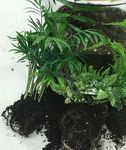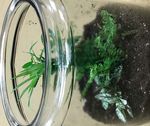TERRARIUM - Mississippi State ...
←
→
Page content transcription
If your browser does not render page correctly, please read the page content below
How to Design a Closed-System
TERRARIUM
Terrariums are beautiful interior accents for the places where people live
and work. Their glassy containers are eye-catching and lead viewers into the
jewel-like plants they contain.
They offer a miniature ecosystem—a window into the natural world. Hu-
mans possess biophilia, a natural, inborn love of nature. While today’s life-
styles may not allow us to be outdoors as much as we might like, in a small
way, terrariums give us a chance to experience nature’s unique flora. Just as
important as a lamp or painting to create a focal point within a room, terrar-
iums are living sculptures. Plus, they can practically care for themselves.
Any clear glass or plastic container is suitable to use as a terrarium. Some
examples include fish bowls, canning jars (both large and small), and an-
tique milk bottles. This, of course, is not an all-inclusive list. The only really
important consideration is that the container not be cloudy or tinted because
this would restrict light and limit plant growth.
TYPES
There are two types of terrariums characterized by the selected container:
open systems and closed systems.
Open-system terrariums use a container with a wide opening such as a
large glass bowl. An open-system terrarium typically needs to be watered
more often than a closed system and has lower humidity levels. One current
trend is to use succulent plants or cacti. These plants are native to dry, arid
regions and have a longer display period in an open-system terrarium. Plants
from both Tables 1 and 2 at the end of this publication can be maintained in
open-system terrariums.
Closed-system terrariums use a closed (or nearly closed) container. A lid-
ded jar similar to the one shown in this publication, or a jar with a narrow
mouth, works well. These containers will sustain the ecosystem necessary
for moisture- and humidity-loving plants (Table 2). Note that this type of
container does not work well with succulents or cacti—they would quickly
rot and die in this setting.
Closed-system terrariums can be surprisingly easy to maintain once their
ecosystem is established. For that reason, this project outlines a closed-sys-
tem terrarium.PRECIPITATION
CONDENSATION
TRANSPIRATION
EVAPORATION
FIND A DISPLAY SITE Avoid placing a terrarium close to a window because solar
Before purchasing plants and supplies, give thought to energy can build heat in the container. This can literally
where the terrarium will be displayed. It is a good idea burn the plants inside.
for it to blend with the interior style. Consider how it can
be shown, whether on a table or a plant stand. LESS IS MORE
Plant-supply departments often carry an array of terrarium
It is best to keep the terrarium in a dedicated space. Limit supplies. You can also find these materials online.
moving it to varying locations because changes in light
intensity and duration may be detrimental to plant health. Beyond the container, decorative accessories can give a
Find a space that has bright, indirect light. Often, an theme to the design. Decorative items can be ceramic,
eastern exposure with morning sun is good for terrariums. glass, metal, or plastic; anything impervious to moisture.
Similarly, a western exposure may work well as long as They can be a dominant part of the design, or they can
afternoon heat is avoided. be subordinate. It is fine to leave them out, keeping the
design natural and unencumbered.
2This example uses heat-treated bark. Do not use bark
intended for outdoor landscapes because it can harbor
pathogens that will introduce disease into the terrarium.
Heat-treated bark for indoor plant use is a nice alternative
to moss or can be used in combination with it for pattern
and textural variety. Similarly, it may be a good idea to
use only one variegated, fancy-leaved plant with other
green plants.
Horticultural-grade charcoal consists of pure carbon chips,
about one-fourth of an inch long. This material is used to
provide a filtering effect to water that has percolated from
the soil mix. You can also use aquarium charcoal, but it
may cost a bit more. Only use clean, washed gravel and
sterile soilless potting mix.
CARE AND DISPLAY
When water droplets (condensation) form on the
inside walls or lid of the terrarium, open the lid for
about an hour. This will allow the excess water to
evaporate. Continue this process until you see very
little if any condensation. At this point, the terrarium
ecosystem has reached equilibrium and can with-
stand long periods without any additional water-
ing—from weeks to years!
One of the goals of terrarium culture is slow growth.
This limits the amount of pruning you will have to
do. Air, moisture, and sunlight will aid in photo-
synthesis, which is the production of light energy
into carbohydrates. This is all a terrarium needs
to thrive. There is no need to add fertilizer to the
closed system.
Finely chopped, heat-treated bark
It is unusual for a terrarium to have a display life Gravel
of longer than a year or two. As plants mature, they Horticultural-grade charcoal
may outgrow the jar. It may become necessary to Potting mix
prune plants or remove them. Take this opportunity Moss (undyed sheet moss)
to refresh the design by rearranging existing plants or Decorative items (miniatures, shells)
adding others. This is a fun and relaxing activity any Mist bottle and water
time of the year! Scissors or snips
Newspaper or other paper
PROJECT MATERIALS*
Container (2-gallon glass jar) *Not all of the listed materials are necessary for every proj-
Plant selections (Neanthe bella palm, nerve plant, Boston ect. Plant supply departments often carry an array of ter-
fern ‘Fluffy Ruffles’) rarium supplies. You can also find these materials online.
3STEPS
Water the plants in their original pots a few hours or the day before construction.
Be sure to wash the terrarium container before using it.
Lay down a few layers of newspaper for easy clean-up of your work surface.
Add 1 inch of gravel to the bottom Make a funnel with two or three Next, add about 2 inches of the soil
of the container. layers of newspaper or other paper. mix to the container. Make a hole in
Using the paper funnel, slowly add the soil large enough to accommo-
about ¼ inch of charcoal. date the plants’ root balls.
Remove plants from their pots and Often, there are multiple plants of the You may need to prune a few
carefully break up the soil at the same variety per pot. Carefully open leaves or stems if they touch the
top and bottom of the root ball. up the root ball with your fingers to sides or lid of the container.
separate plants into smaller pieces.
4Place the tallest plants toward the Add the plants and tamp down Now it is time to water the terrari-
center and the remaining plants the soil around the rootball. um. Using a mist bottle, mist the in-
around the center. Allow a bit of terior sides of the glass jar. This not
space between them, and evaluate only provides water to the soil, but
the need for additional pruning. it also helps to wash charcoal dust
or other organic materials from the
glass. You can tell the soil is moist-
ened by the way its color appears
saturated. Be sure to heavily mist
the root ball area of each plant, but
do not fully saturate the soil. Water
can always be carefully added to the
terrarium, but not drained from it.
Break up large pieces of moss
and add them to the soil surface
in patches. Add chopped bark
to other patches. Finally, add
decorative items.
5To establish the moisture balance within
the terrarium, follow these steps:
1. After finishing the project, leave the
container open for about 24 hours.
This will allow excess water vapor to
escape.
2. Replace the lid for 24 hours.
3. Remove the lid for another 24 hours,
allowing condensation to evaporate.
4. Replace the lid again for another 24
hours.
5. Keep repeating this process until there
is no moisture collecting on the inside
glass of the terrarium. At this point, the
terrarium has reached an equilibrium
and will not need to be watered for
weeks, perhaps months, at a time.
Foliage or stems resting against any of the interior glass surface can be detrimental
to the health of the leaf, plant, and entire terrarium system. The surface of the leaf
gives off water vapor; if it is near the glass, moisture will be trapped and create an
environment for disease. Similarly, it is best to keep plants from touching each other
to avoid rapid disease spread.
6Table 1. Plants (cacti and succulents) Table 2. Plants suitable for both open- and closed-system terrariums.
suitable for open-system terrariums. African violets (including miniature Norfolk Island pine
Aeonium African Violets) Orchid (such as miniature
Aloe vera Anthurium (miniature varieties) Phalaenopsis)
Burro’s tail Ardisia Palms
Cactus Artillery fern Peperomia
Crown of thorns Baby’s tears Philodendron
Devil’s backbone Bead plant Pilea
Echeveria Creeping fig Plumosa fern
Flaming Katy (Kalanchoe) Croton Pothos
Hens and chicks Dieffenbachia Purple velvet plant
Jade plant Dracaena Rabbit’s foot fern
Panda plant Dwarf schefflera Rex begonia
Pencil plant Fern Selaginella
Flame violet Spider plant
Gold dust Dracaena Strawberry begonia
Ivy Tillandsia
Lipstick plant Venus fly trap
Maidenhair fern Zebra plant
Nerve plant
REFERENCES
Carloftis, J. (2006). Beyond the windowsill. Franklin, TN: Cool Springs Press.
DelPrince, J. (2013). Interior plantscaping: Principles and practices. Clifton Park, NY: Delmar.
FTD Fresh. (2014). Twenty popular types of succulents. Retrieved from https://www.ftd.com/blog/share/types-of-succulents
Hessayon, D. (1998). The house plant expert. London: Transworld Book.
Martin, T. (2009). The new terrarium. New York, NY: Clarkson Potter.
Pleasant, B. (2005). The complete houseplant survival manual. North Adams, MA: Storey.
7The information given here is for educational purposes only. References to commercial products, trade names, or suppliers are made with the under- standing that no endorsement is implied and that no discrimination against other products or suppliers is intended. Publication 3253 (POD-08-18) By James M. DelPrince, PhD, Assistant Extension Professor, and Gary Bachman, PhD, Extension/Research Professor, Coastal Research and Extension Center. Copyright 2018 by Mississippi State University. All rights reserved. This publication may be copied and distributed without alteration for nonprofit educational pur- poses provided that credit is given to the Mississippi State University Extension Service. Produced by Agricultural Communications. Mississippi State University is an equal opportunity institution. Discrimination in university employment, programs, or activities based on race, color, ethnicity, sex, pregnancy, religion, national origin, disability, age, sexual orientation, genetic information, status as a U.S. veteran, or any other status protected by applicable law is prohibited. Questions about equal opportunity programs or compliance should be directed to the Office of Compliance and Integrity, 56 Morgan Avenue, P.O. 6044, Mississippi State, MS 39762, (662) 325-5839. Extension Service of Mississippi State University, cooperating with U.S. Department of Agriculture. Published in furtherance of Acts of Congress, May 8 and June 30, 1914. GARY B. JACKSON, Director
You can also read



























































